Welcome to the fourth installment of our tutorial series, Track Breakdown.
In this series, we take a take a popular song, dissect it, trying to figure what makes that song work.
I aim to teach you the techniques used in each track so you apply them to your own productions.
In this breakdown, we’ll look at Madeon’s Imperium, the first single off his debut album Adventure.
First, we’ll look at the main melodic content of the track. Then, we’ll breakdown the composition and arrangement. Finally, I’ll try to breakdown what I think makes Madeon’s music so catchy and memorable.
Let’s get to it.
Get 25 high-quality MIDI chord progression files for free 🎹
Our Track Breakdown MIDI Vault is packed with chord progression MIDI files from songs like Mura Masa’s ‘Lovesick’, Flume’s ‘Say It’ & more! 👇
The Sauce
Imperium is in the key of F minor.
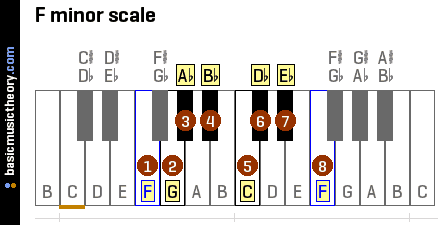
Below is the main chord progression:
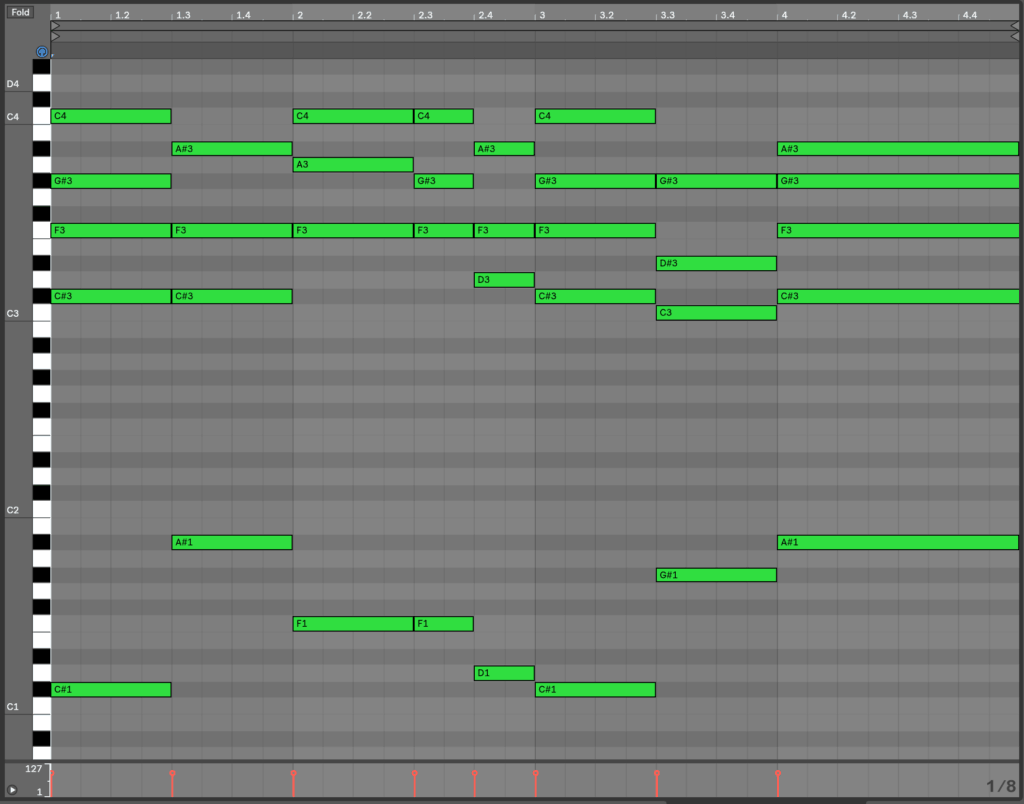
Listen here:
What are we working with?
The basis for this progression is: [Dbmaj7 – Bbm – F – Fm – Bb/D] – [Dbmaj7 – Ab – Bbm7]
- Dbmaj: Db – F – Ab – C
- Bbm: Bb – Db – F
- F: F – A – C
- Fm: F – Ab – C
- Bb/D: Bb – D – F with a D bass
- Dbmaj7 (again)
- Ab: Ab – C – Eb
- Bbm7: Bb – Db – F – Ab
(I’m playing a few of the chords above inverted, i.e. I rearranged the order of the notes. Specifically, I’m playing Bbm, Bb/D, Ab, and Bbm7 inverted)
This progression might seem like a lot to take in, but I promise we’ll break it down and make it easy to understand. Regardless of your theory knowledge, I’m confident I’ll be able to take you through this song, helping you understand how Madeon is able to write and arrange a song.
Want the MIDI from this article? Download it in our MIDI vault below!
Get 25 high-quality MIDI chord progression files for free 🎹
Our Track Breakdown MIDI Vault is packed with chord progression MIDI files from songs like Mura Masa’s ‘Lovesick’, Flume’s ‘Say It’ & more! 👇
Key Takeaways:
- Modal Mixture
- Voicing for Cleanliness
- Voicing for Emotion
- Tension with a Purpose
- Multiple Hooks (Arrangement Analysis)
- Focused Attention to Detail
1. Modal Mixture
Let’s take a look at how Madeon built this progression. We’ll go chord by chord, looking at where each chord comes from and what role it serves.
Here is the progression: [Dbmaj7 – Bbm – F – Fm – Bb/D] – [Dbmaj7 – Ab – Bbm7]

Listen here:
The first chord is Dbmaj7. Db is the 6th scale degree of Fm, making it the VI (six) chord. This chord is diatonic to F minor, a solid choice to start the progression.
The next chord is Bbm. Bb is the 4th scale degree of Fm, making it the iv (four) chord. If you look closely, Dbmaj7 and Bbm share two common tones, resulting in a smooth transition between the two.
The third chord is F. However, the F major triad (F – A – C) isn’t in the key of F minor. Specifically, we don’t have a natural A in the key of F minor, only an Ab. Where does this chord come from?
This F chord is what we call a borrowed chord. Those of you that read the previous track breakdown will remember that a borrowed chord is a chord borrowed from a parallel key.
In this track, the parallel key would be F major, since the song is in F minor. This means he can “borrow” any chord from the F major scale and insert it into his progression.
Listen back to the chord progression, and notice how the mood of the track shifts when the F is played
Listen here:
Notice how the first two chords fit nicely together, then the third chord hits and catches you off guard? This is because the F chord isn’t “diatonic” to F minor, the tonal center established by the first two chords of the song.
So if the F throws the listener off course, has does Madeon bring you back?
With the strongest chord in F minor: Fm.
Since Fm is the one chord of F minor, it’s the “home base”’ of the key. Thus, when the progression plays ab Fm, we feel a sense of relief.
This chord movement works because even though were thrown off by the F, we resolve back to the one chord of the scale, which happens to have the same root note as the chord before it (i.e. they’re both some type of F chord).
At the end of the first two bars there is a Bb/D. I’ll explain what this chord is later, but for now, know that it is also a borrowed chord.
When you use borrowed chords in a progression, you’re creating what’s called a modal mixture. Remember, a mode refers to a type of scale (major, minor, etc..).
Since Imperium is in F minor and borrows chords from F major, we say this progression is a modal mixture of both F major and F minor.
Personally, I think this is really cool. You’re able to take the emotional quality of two different scales, and combine them to create something new. I love modal mixture because it’s putting a name to a technique we’ve all heard in action and all (hopefully) enjoy.
—
The second half of the progression goes back to the Dbmaj7. The progression has already established this as it’s home base, so it’s a strong chord to go back to.
This time through, instead of playing the same progression back again, he moves to an Ab major chord (Ab – C – Eb). Ab is the 3rd scale degree of Fm, making it the III (three) chord.
Madeon ends this progression by going back to the Bbm chord from earlier, this time adding a seventh on top. This rich minor seventh chord is a great resolution to this emotional progression. He used the chord before, so there’s a sense of familiarity when it comes back. Madeon also plays the chord for a full bar, really cementing that this chord is the final stretch home.
2. Voicing for Cleanliness
If you’re familiar with this track, you might be thinking there’s a lot more going on then just this 4 bar progression. If so, you’re completely right.
Even though this progression is the foundation for the track, we never actually see it in this form. Let’s look at how Madeon actually presents this progression.
The first time we hear this progression is during the verse (it’s teased in the intro, but we’ll ignore that for now).
First off, this progression is split between two instruments: chords and bass. The chords are a big saw stack, and the bass in the same plucky saw present in the intro. Madeon took this progression and split it between these two instruments. Let’s take a look at them.
Below is my transcription of the chords.

Listen:
Below is my transcription of the bass.
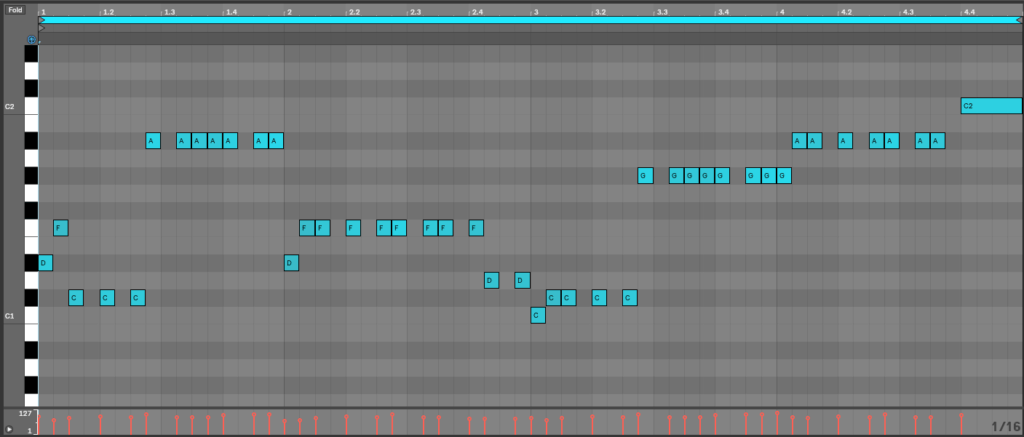
Listen:
For reference, listen to what the chords and bass sound like played together.
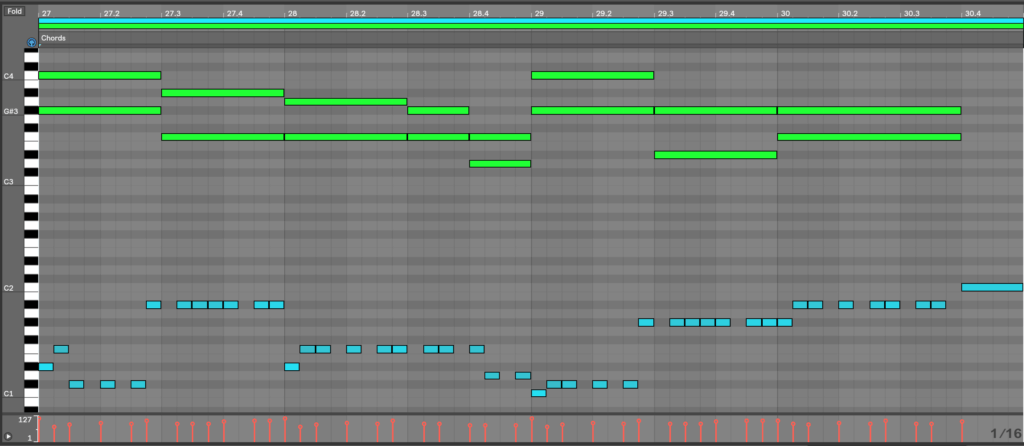
Listen:
To simplify this, let’s look at these played with the bass stripped of its rhythm.
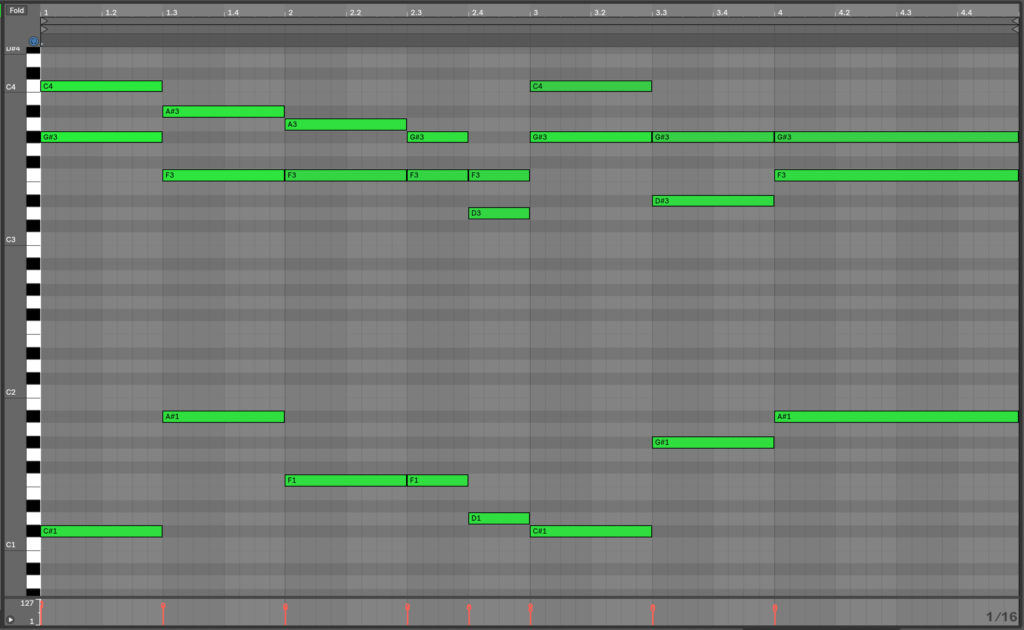
Listen:
Notice a difference between this progression and the first one I showed you?
First off, there are a lot less notes in the progression above. For example, recall that the first chord is a Dbmaj7 (Db – F – Ab – C). In the actual track, we don’t have an F playing in the first chord, only Db in the bass, and Ab and C in the chords.

Despite this, the chord structure is still a Dbmaj7, only without the F (i.e. it’s omitted). This is perfectly fine to do. We can still have an Dbmaj7 without the F.
What’s the point of leaving that note out? In my opinion there are two reasons:
- Cleanliness
- Emotional Quality of the Chord.
We’ll tackle the latter in the next section, so for now let’s deal with the former.
There is a lot going on in this song (like most Madeon songs). From both a melodic and sonic standpoint, this song is incredibly dense.
During each section, there are dozens of elements fighting for space in the mix.
Thus, would it make sense to have an obnoxiously big chord that takes up half the mix, or a powerful but controlled chord that leaves rooms for the rest of the track?
The latter.
By removing certain voices from each chord, Madeon is able to make more room for everything else in the track. Sure, he loses a bit of power from the chords, but the rest of track more than makes up this.
In other words, by thinning out these chords, Madeon is able to make a fuller and cleaner mix.
How can you apply this to your own music?
Think carefully about the amount of voices in your chords. Do you need all 5 voices in the chord, or could you do without some? Does every instrument need to be playing each voice, or can you split the voices across multiple tracks?
3. Voicing for Emotion
When adding or removing voices from a chord, it’s important to consider what it does to the emotional quality of the chord.
Let’s look at the first chord in the progression, a Dbmaj7 (Db – F – Ab – C).

The saw chords are only playing two of the four voices (Ab and C), leaving out both Db and F.
The bass is playing a Db, so it’s perfectly fine to leave it out of the chord, since it’s already present in the song.
What about the F? In a Dbmaj7 chord, F is the third of the chord. You might remember that the third of a chord is what makes it major or minor. Leaving out the third creates a more “ambiguous” sound, one that’s not necessarily major or minor.
Is this a good thing to do? The average theory teacher would advise against leaving out the third, but in this context it works.
When removing notes for cleanliness, it’s important to still get the chord across. When choosing which notes to remove, carefully listen for a change in the emotional quality of the chord.
To show this, let’s listen to the transcription I gave in the first section versus the actually voicing Madeon used in the song.
First, we’ll hear the actual track voicing, followed by the full voicing. I’ve highlighted the notes Madeon left out in the image below.
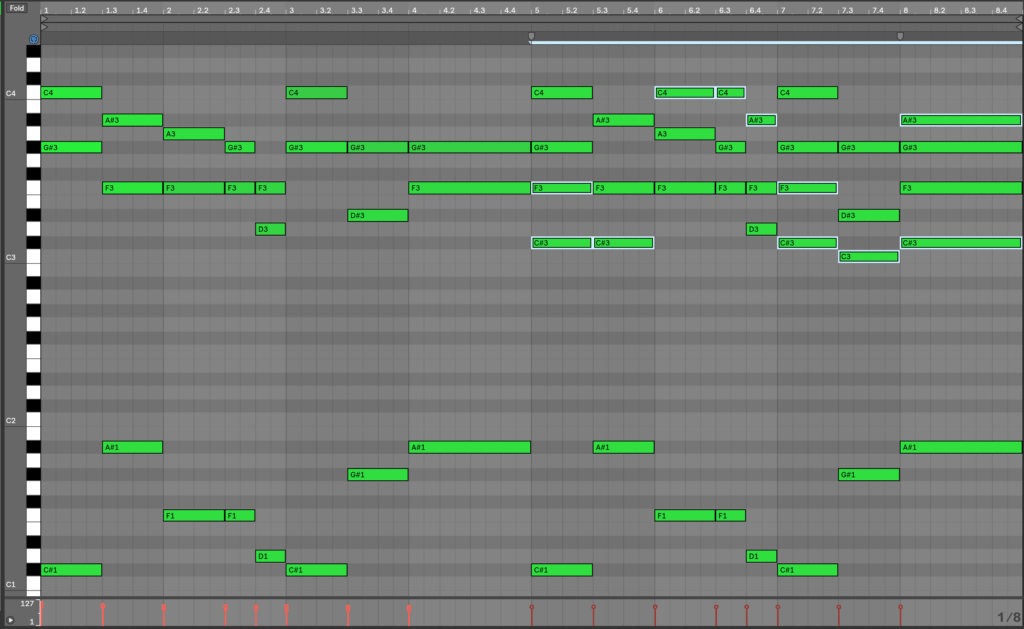
Listen:
Does the first progression have the same “feel” as the second?
I think so. It’s not as full as the second, but as discussed earlier this isn’t necessarily a bad thing.
By removing select notes from each chord, Madeon is able to clean up the progression while still achieving the same overall message.
Takeaway: When adding or removing notes from a chord, consider how its affects the emotional quality of the chord and the overall progression.
4. Tension With A Purpose
Earlier, we saw that the first half of the progression ended with this strange Bb/D chord (Bb – D – F with a D bass) .
Listen for this chord, which I’ve highlighted in the image below.
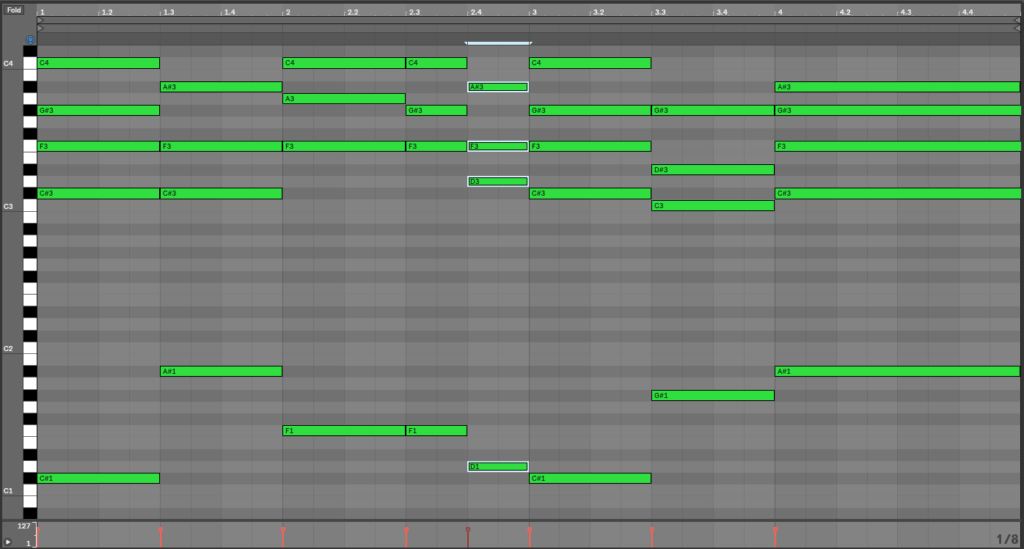
Listen:
This chord is quite harsh, right? Also, it’s not diatonic since the middle note of the chord (D) isn’t in the key of F minor.
So where did this chord come from, and what’s its purpose?
A good guess is that it came from the parallel major scale, F Major.
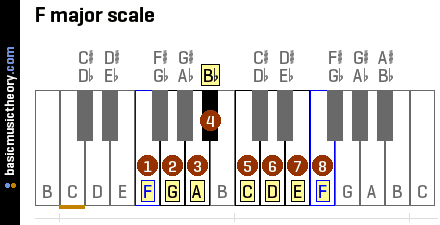
Looking at the chart above, we can see that Bb (Bb – D – F) is in the key of F major. In other words, this Bb chord is borrowed from the parallel major of the F minor, F major.
Now that we know where it came from, what does it do for this progression?
As I mentioned earlier, this chord sounds rather harsh. Let’s listen back to the progression, focusing in on this chord (especially the bass note).
Although the chord sounds out of place, in the context of this progression it works.
Why is this?
This Bb/D is able to cut through the track, building tension that’s immediately released. It builds up tension (through modal mixture), quickly releasing this tension once the progression turns around.
We can liken the role of this chord to that of a drum fill. The function of this chord is similar to that of a drum fill in that
- It’s an abrupt change that grabs the listener’s attention.
- It’s immediately resolved by the start of a new section/progression.
- We wouldn’t want to hear it for too long.
The harsh, abrupt move to a Bb/D chord works because the chord serves a specific function in the progression.
This idea is something your favorite artists understand, as Madeon sure as heck does:
Every chord has a distinct emotional quality. It’s how you stitch these chords together that gives your song a story worth listening to.
5. Multiple Hooks (Arrangement Analysis)
Madeon has an incredible ability to develop a track, creating compelling sections that stand up strong on their own.
What do you think is the hook of Imperium? Is it the vocal intro, the pouding baseline, or one of the multiple toplines?

It could be any one of these. There are multiple compelling hooks scattered throughout the track.
This is part of what makes this track so memorable and compelling: there are several distinct and catchy hooks.
Unfortunately, there isn’t a quick fix to be able to write like this. Madeon’s ability to craft multiple hooks is part of what makes him ten steps ahead of the competition. I hope this fact doesn’t discourage you; rather, I hope it motivates you to constantly develop and refine your craft.
6. Focused Attention to Detail
For this breakdown, I transcribed every core melodic element in the song. One of the most interesting aspects of my analysis was that the same bass pluck plays 5 different melody lines.
How many dance tracks do you know of that have 5 distinct basslines?
I’m guessing not many.
There is a different bassline for the into, first verse, post chorus, second verse, and final chorus.
Madeon didn’t switch up the bassline just for fun. Every time he introduced a new baseline, he did so with a purpose. He altered the bass’s function to make it fit better contextually:
- During the intro, the bass in melodically active and rhythmically, serving as the core focus of the section.
- During the verse, the rhythm is kept the same but the notes are changed to complement the chords.
- During the post-chorus, the melody is changed to reflect a chord change and build tension towards the end of the section.
- During the second verse, the bass plays straight 1/16th notes, adding tension that compliments the energy in that section.
- During the final chorus, the rhythm is simplified to pull attention away from the bass, making it serve as a background element.
This is an attention to detail that is truly exceptional. It’s what separates the Madeons of the world from the producers trying to chase them.
—
To help you contextualize this, let’s briefly look at the 5 bass melodies Madeon uses (there are actually more than 5, but to my ear these are the 5 most “distinct” patterns)
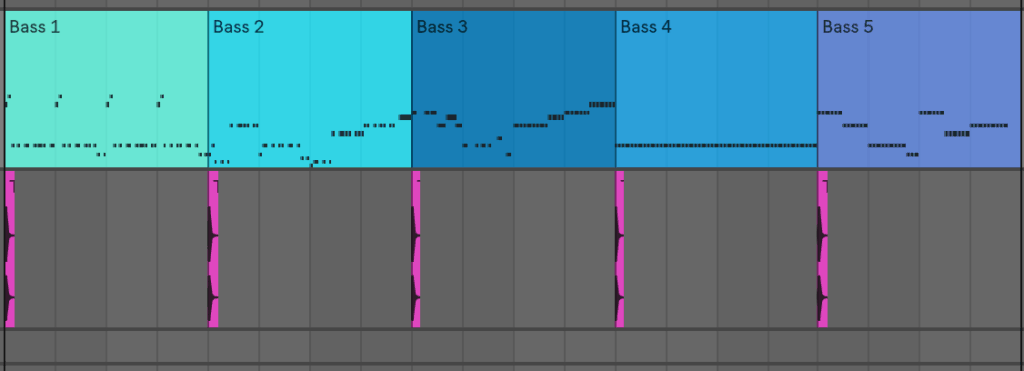
Listen:
(I included a clap sample at the start of each clip to signal the start)
In the image below, we can see where Madeon places each of these basslines in the track.

Again, it’s this hyper-focused attention to detail that makes songs like Imperium stand out from the rest.
Analysis
At this point, you should be asking yourself, “How in the world does Madeon pull this off?”
There is a lot going on in this track, and we haven’t even begun to touch the sound design and mixing.
So how is Madeon able to do this? What separates him from everyone else?
For me, it boils down to one key characteristic: intuition.
Intuition: a thing that one knows or considers likely from instinctive feeling rather than conscious reasoning.
Theoretically speaking, this track makes sense. The combination of modal mixture and slash chords add tension and excitement to the progression.
How much of this was conscious? When writing Imperium, was Madeon saying to himself “I need to build tension, so I’ll borrow the four chord from the relative major and use a slash chord for proper voice leading?”
Odds are, he probably wasn’t.
More likely, he was going with what he felt sounded best. Sure, there’s theory to back up the decisions he made, but I’d imagine he simply experimented with the progression until he found one he liked, paying little to no attention to the technicality behind it.
Madeon’s been quoted saying he doesn’t know much music theory, so this is probably the case.
This begs the questions, “How is Madeon able to write so well by ear?”
This goes back to intuition. For whatever reason, Madeon is able to write truly outstanding music by mere instinct.
For most people, this is easier said than done: writing by instinct can only get you so far. Sure, the Deadmau5s and Madeons can do it, but for the average producer, instinct alone isn’t enough to help them write the music they’re truly capable of.
How do I deal with this reality? I never stop learning, and I never stop listening.
Rather than envy the musical skill of my favorite artists, I remind myself that I’m lucky to have so much exceptional music to listen to and to learn from.
I trust my intuition, doing everything I can to make it better and better.
Want free access to the Track Breakdown MIDI Vault? You can download the MIDI from all of our Track Breakdowns, as well as 25 hi-quality MIDI chord progressions you can use in your own productions.
Get 25 high-quality MIDI chord progression files for free 🎹
Our Track Breakdown MIDI Vault is packed with chord progression MIDI files from songs like Mura Masa’s ‘Lovesick’, Flume’s ‘Say It’ & more! 👇
Summary
I hope you were able to take away some useful tips from this article. Learning proper songwriting is a difficult process, and I want to help make the journey as easy as possible for you.
I tried to pull out as much valuable information as I could from this song, helping you to better understand what makes a great song, well, great.
There’s a good amount of information to digest here, so I’d recommend re-reading it a few times to soak up all the different elements.
The point isn’t to memorize everything in this article, but to let this article guide your workflow, adding additional tools to your music-writing arsenal.
As always, feel free to ask me questions in the comments!
Want to read more breakdowns? Click here to visit the Track Breakdown Glossary.
Disclaimers:
The transcriptions aren’t 100% exact, but they’re essentially there. The point of this article wasn’t to exactly copy the song; rather, I wanted to get the general idea of the melodies and chords, so as to further break them down. Also, there are certain subtleties I left out to make the teaching more direct and effective.

